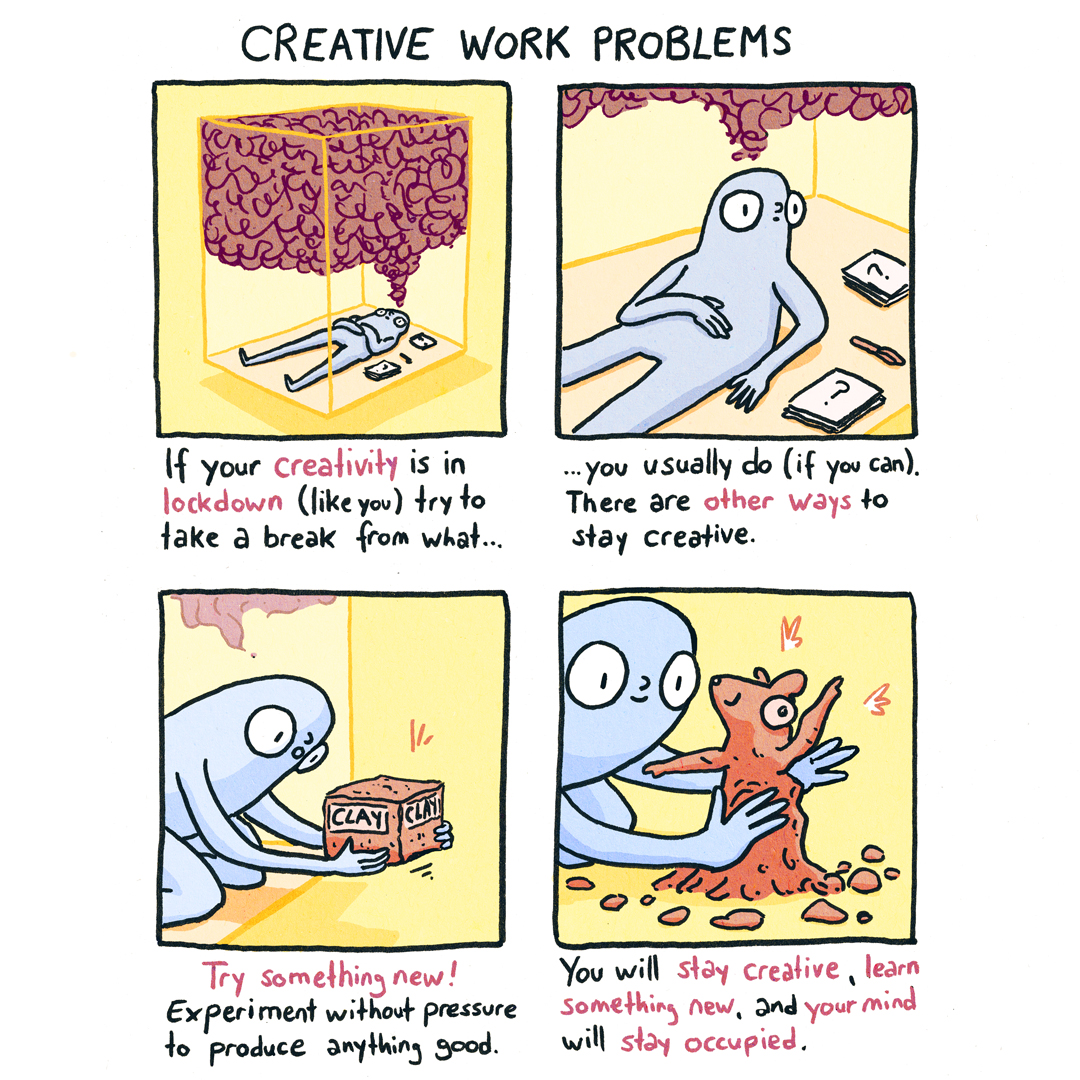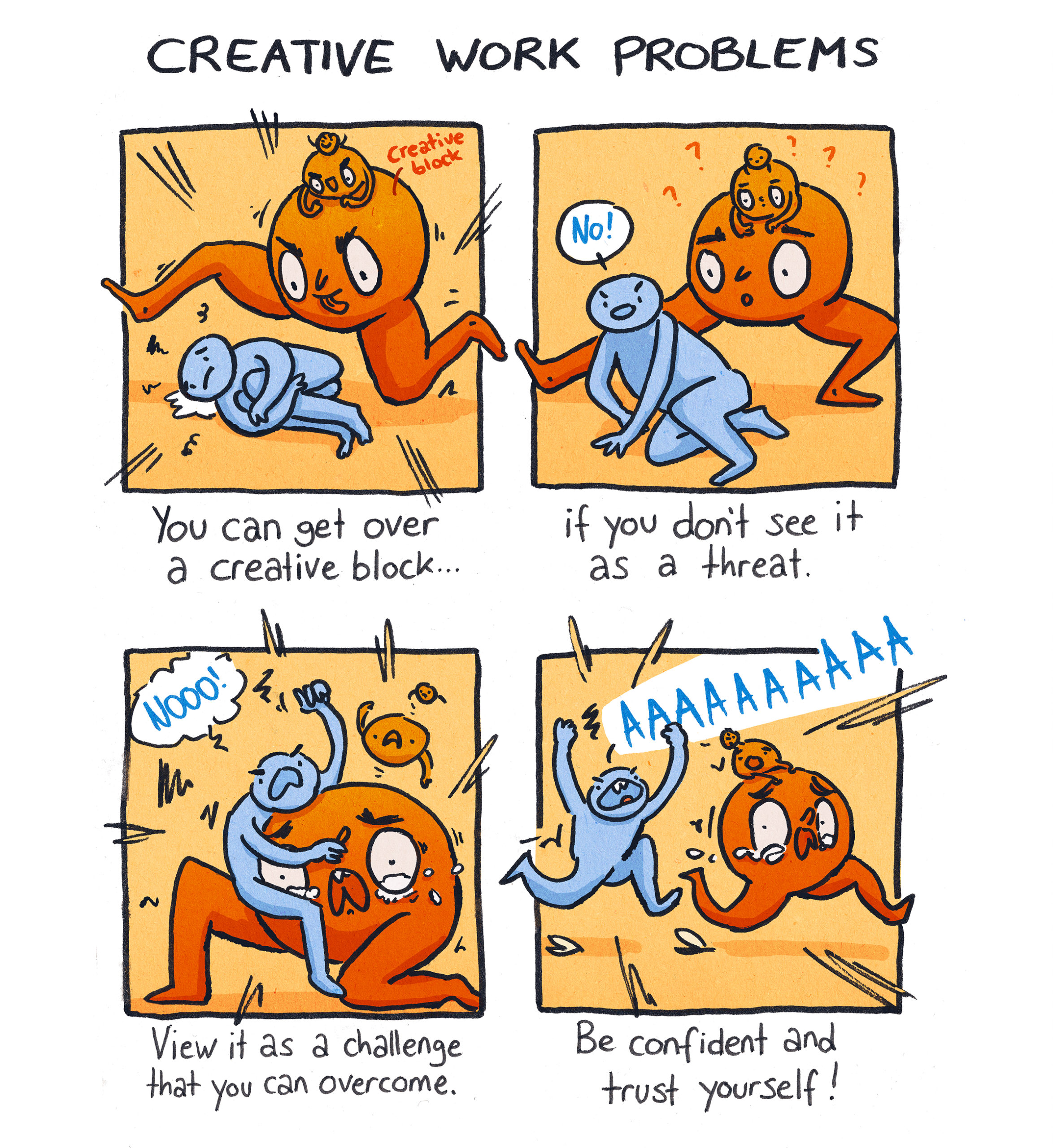
Table of Contents
There are various names for this phenomenon — writer’s block, creative block, or art block. I made a list a while back with some suggestions if you have this problem. Today I’ll show you a different approach with an exercise.
This exercise includes a) different steps you do in a relaxed body position, b) mental imagery exercises, and c) a visualization of your art block.
It can also help you solve daily creative problems in your work. For example, if you get stuck on a project and don’t know what to do. That’s why I will test and do this exercise myself too.
I have adapted this exercise so you can do it alone, as it is usually done with a therapist who guides you. This means that I will change this exercise over time with feedback.
What Can Help With Art Block?
There is evidence that vivid daydreaming helps with a creative block. That’s why we do an exercise that enhances this.
We all know when we go for a walk with a problem in our mind, we find the solution before we even come back from the walk. In this sense, daydreaming can help us when we have this issue.
But how can we deliberately start this daydreaming? Of course, we can encourage it by doing nothing and letting our thoughts run free. By doing something other than our creative work and thus letting daydreaming take its course. Or just do something else, like Kness did when she had art block. Or we can apply this solution with an exercise, which encourages daydreaming. As a result, it helps with our creative block.
One part of the exercise is a series of mental imagery exercises that form the basis of the Creative Imagination Scale. I’ll give you this part of the exercise in short, there is a link below for more details.
The Concept of The Mental Imagery Exercise
There are 10 parts to the exercise. Here’s an overview of these parts (the actionable and adapted exercise is further below).
- Arm Heaviness
- Think about how your arms are getting heavier.
- Hand Levitation
- Think about how your arms are getting lighter.
- Finger Anesthesia
- Imagine your fingers going numb.
- Water “Hallucination”
- Imagine drinking cool refreshing water.
- Olfactory-Gustatory “Hallucination”
- Think about how you perceive the taste and smell of an orange.
- Music “Hallucination”
- Listen to music in your mind that you heard the other day.
- Temperature “Hallucination”
- Imagine your arms getting warm.
- Time Distortion
- Try to slow down time with your thoughts.
- Age Regression
- Imagine going back in time, e.g. childhood.
- Mind-Body Relaxation
- Try to relax your mind and body.
The Problem With This Exercise
And what’s the problem? A therapist should guide you through this whole exercise, while you are in a relaxed state. It is quite difficult to do with no therapist around. Hence, we’re going to change it up a bit and do it ourselves!
Go through the mental imagery exercise before you start it, preferably writing it down, and try to imagine how you do every point of this. Look for personal examples such as point 8 “Time Distortion”. When is the moment in time you will imagine? Then try to remember these points as best as you can.
If you do the exercise and forget a few things, don’t worry! It’s not a problem at all. If you do the exercise over and over again, you will memorize everything and incorporate the forgotten things.
The Exercise Against Art Block
Remember this exercise and then let’s do this!
- Sit in a dark room with your eyes closed and focus on relaxing your body and mind.
- Now describe to yourself the contents of your ongoing thoughts and fantasies.
- Do the mental image exercises as mentioned. No more than 1.5 minutes for each exercise.
- Arm Heaviness
- Hand Levitation
- Finger Anesthesia
- Water “Hallucination”
- Olfactory-Gustatory “Hallucination”
- Music “Hallucination”
- Temperature “Hallucination”
- Time Distortion
- Age Regression
- Mind-Body Relaxation
- Now visualize or otherwise experience the elements of your current creative work. Imagine your creative block. What do you want to work on right now? What are the problems and solutions to this? How do you move on?
- Come back to reality. Stretch your limbs. Breathe deeply. Open your eyes.
Repeat this daily for two weeks or more. You can do this as a ritual before doing (or trying to do) any creative work.
Conclusion
While there are many ways to tackle a creative block, I am trying to give you a new, evidence-based approach. I have adapted this exercise for you to do on your own, so we need more evidence to see if it works without help. If you have someone to help you, you could use the real exercise down at the sources.
Because this is a work in progress and I’ll continue to adjust the exercise after feedback. So, if you do the exercise for a while, it would be super nice if you could send me your feedback! I will adapt and improve the exercise so that it is even more applicable and can help you.
Sources
Mental imaginary exercises from the Creative Imagination Scale https://hypnosisandsuggestion.org/
Singer, J. L., & Barrios, M. V. (2009). Writer’s block and blocked writers: Using natural imagery to enhance creativity. In S. B. Kaufman & J. C. Kaufman (Eds.), The psychology of creative writing (pp. 225–246). Cambridge University Press. https://doi.org/10.1017/CBO9780511627101.016
Barber, T. X., & Wilson, S. C. (1978). The Barber Suggestibility Scale and the Creative Imagination Scale: Experimental and clinical applications. The American journal of clinical hypnosis, 21(2-3), 84–108. https://doi.org/10.1080/00029157.1978.10403966

